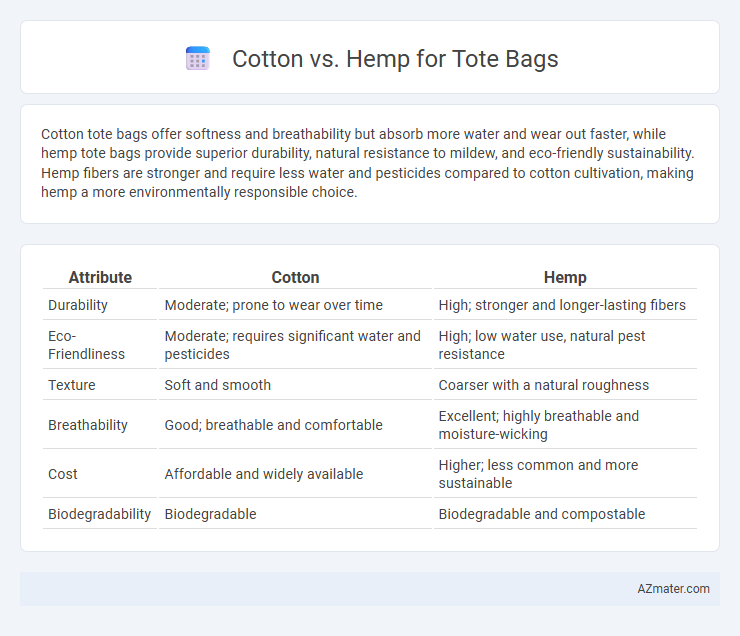Cotton tote bags offer softness and breathability but absorb more water and wear out faster, while hemp tote bags provide superior durability, natural resistance to mildew, and eco-friendly sustainability. Hemp fibers are stronger and require less water and pesticides compared to cotton cultivation, making hemp a more environmentally responsible choice.
Table of Comparison
| Attribute | Cotton | Hemp |
|---|---|---|
| Durability | Moderate; prone to wear over time | High; stronger and longer-lasting fibers |
| Eco-Friendliness | Moderate; requires significant water and pesticides | High; low water use, natural pest resistance |
| Texture | Soft and smooth | Coarser with a natural roughness |
| Breathability | Good; breathable and comfortable | Excellent; highly breathable and moisture-wicking |
| Cost | Affordable and widely available | Higher; less common and more sustainable |
| Biodegradability | Biodegradable | Biodegradable and compostable |
Introduction to Cotton and Hemp Tote Bags
Cotton tote bags, made from natural fibers derived from the cotton plant, offer softness, breathability, and widespread availability, making them a popular choice for everyday use. Hemp tote bags, crafted from the hemp plant's strong fibers, provide exceptional durability, resistance to wear and mildew, and eco-friendly qualities through sustainable cultivation practices. Both materials contribute to reusable, biodegradable bags, with hemp boasting a lower environmental footprint due to less water usage and pesticide requirements compared to conventional cotton.
Environmental Impact: Cotton vs Hemp
Hemp requires significantly less water and pesticides compared to cotton, making it a more sustainable choice for tote bags. Cotton farming often leads to soil degradation and high greenhouse gas emissions, while hemp regenerates soil health and absorbs more CO2. Hemp's rapid growth and low-resource needs contribute to a smaller environmental footprint than conventional cotton production.
Durability and Strength Comparison
Hemp fibers exhibit superior durability and tensile strength compared to cotton, making hemp tote bags more resistant to wear and tear over time. Hemp's natural resistance to stretching and UV degradation ensures that bags maintain their shape and integrity under heavy loads. In contrast, cotton fibers tend to weaken faster with repeated use and washing, resulting in less robust tote bags overall.
Cost and Affordability
Hemp tote bags typically cost 20-30% more than cotton equivalents due to higher processing expenses and limited large-scale farming. Cotton bags offer greater affordability, benefiting from widespread cultivation and established industrial supply chains. The durability and longevity of hemp bags often translate to better long-term value despite the initial higher price.
Aesthetic and Design Varieties
Cotton tote bags offer a wide range of vibrant colors and intricate patterns, catering to diverse aesthetic preferences with smooth textures and easy dye absorption. Hemp tote bags boast a natural, rustic look with a unique coarse weave that ages beautifully over time, appealing to eco-conscious consumers seeking organic and minimalist designs. Both materials support customization, but cotton's pliability allows for more detailed prints, while hemp's sturdy fibers ensure durability in bold, simple styles.
Comfort and Texture Differences
Cotton tote bags offer a soft, smooth texture that feels gentle against the skin, making them highly comfortable for everyday use. Hemp tote bags have a coarser, sturdier weave that provides durability but may feel rougher to the touch initially. Over time, hemp softens with washing while maintaining its strength, offering a unique balance between ruggedness and comfort.
Production and Sustainability Factors
Hemp tote bags outperform cotton in sustainability due to hemp's lower water and pesticide requirements, as hemp cultivation uses up to 50% less water and avoids synthetic chemicals. Hemp fibers grow faster and produce higher yields per acre, making them a more eco-efficient raw material compared to cotton, which demands intensive irrigation and significant pesticide application. The production process for hemp results in less soil degradation and a smaller carbon footprint, positioning hemp as the more environmentally friendly choice for durable and sustainable tote bags.
Maintenance and Care Tips
Hemp tote bags require minimal maintenance, as the natural fibers are resistant to mold, mildew, and stretching, making them easy to clean with cold water and mild detergent. Cotton tote bags demand more frequent washing to prevent stains and retain their softness, but should be air-dried to avoid shrinking. Both materials benefit from spot cleaning and avoiding bleach to maintain color vibrancy and fabric integrity over time.
Popular Uses and Market Trends
Cotton tote bags dominate the market due to their softness and affordability, making them a popular choice for everyday use and promotional items. Hemp tote bags gain traction for their durability, eco-friendliness, and resistance to mold, attracting environmentally conscious consumers and niche markets. Market trends indicate a growing demand for sustainable materials, boosting hemp's share while cotton remains a staple in mass production.
Choosing the Right Material for Your Tote Bag
Cotton tote bags offer softness and breathability, making them ideal for everyday use and lightweight carrying, while hemp provides superior durability, resistance to wear, and eco-friendly benefits due to its fast-growing, pesticide-free cultivation. Hemp fibers create a sturdier, long-lasting tote bag that resists stretching and can handle heavier loads, which is perfect for frequent shoppers or carrying bulkier items. Selecting between cotton and hemp depends on your priorities for sustainability, bag longevity, and texture preferences in daily use.

Infographic: Cotton vs Hemp for Tote Bag
 azmater.com
azmater.com